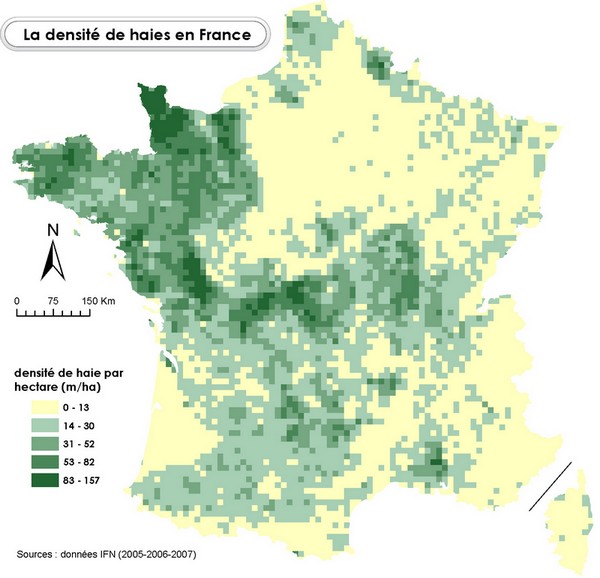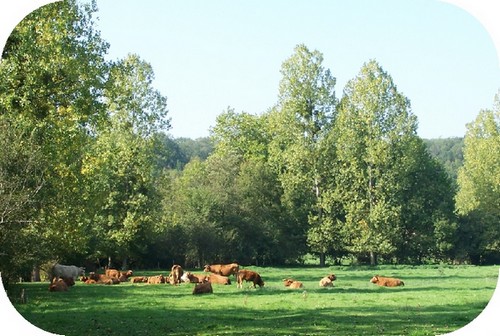According to the summary produced by Jean-Christophe Tourneur and Stéphane Marchandeau (ONCFS, 1996)
![]() The term bocage refers to a type of rural landscape resulting from a combination of changes in the natural environment and in rural society.
The term bocage refers to a type of rural landscape resulting from a combination of changes in the natural environment and in rural society.
![]() This typical Western European terrain, which in France is especially prevalent in the western Armorica, western Vendée, Limousin, Bourbonnais, Thiérache and Pays Basque regions, is almost directly opposed to the open-field landscapes of eastern France, Rhineland and eastern Germany, and certain parts of eastern Europe.
This typical Western European terrain, which in France is especially prevalent in the western Armorica, western Vendée, Limousin, Bourbonnais, Thiérache and Pays Basque regions, is almost directly opposed to the open-field landscapes of eastern France, Rhineland and eastern Germany, and certain parts of eastern Europe.

![]() Although bocage is a long-established feature of our countryside, and may have existed since the iron age, it became much more widespread starting in the 18th century, when strong population growth combined with the breaking up of properties previously owned by the nobility led to the subdivision of communal land and large estates (Flatres, 1976 - Meynier, 1976).
Although bocage is a long-established feature of our countryside, and may have existed since the iron age, it became much more widespread starting in the 18th century, when strong population growth combined with the breaking up of properties previously owned by the nobility led to the subdivision of communal land and large estates (Flatres, 1976 - Meynier, 1976).

![]() Meynier, in 1976, defined bocage as "a lush, enclosed landscape". Although surprisingly simple, this definition is universally accepted by geographers and ecologists. Strictly speaking, bocage environments feature a network of hedgerows forming a patchwork of variable size and geometry, and they consist of or are bounded by a strip of vegetation - live hedges in most but not all cases Flatres, (1976 and 1993 –Mondolfo & Lorfeuvre, 1986, inter alia).
Meynier, in 1976, defined bocage as "a lush, enclosed landscape". Although surprisingly simple, this definition is universally accepted by geographers and ecologists. Strictly speaking, bocage environments feature a network of hedgerows forming a patchwork of variable size and geometry, and they consist of or are bounded by a strip of vegetation - live hedges in most but not all cases Flatres, (1976 and 1993 –Mondolfo & Lorfeuvre, 1986, inter alia).
![]() There are many variations on this basic theme, ranging from bocage fields in the Massif Central that are enclosed by hedges but no earth banks to the dense networks of small hedged fields found in parts of Basse-Normandie.
There are many variations on this basic theme, ranging from bocage fields in the Massif Central that are enclosed by hedges but no earth banks to the dense networks of small hedged fields found in parts of Basse-Normandie.
![]() There are many subcategories, depending on the type of land and the type of enclosure, the dominant tree species, the shape and scale of the field patchwork and the origins of the bocage. According to the latter criterion, there are three basic types (Soltner, 1986 & 1991, inter alia): secondary bocage, semi-bocage and degraded bocage. Numerous authors (Baudry and Burel, 1985 - Burel, 1990 - Coutel, 1992, inter alia) have emphasised the importance of not considering merely the field pattern, but also the structure of the hedgerows that define it. They stress the heterogeneous nature of the bocage network, which is apparent in both the spatial distribution and individual composition of hedgerows, while historical factors have influenced their distribution density.
There are many subcategories, depending on the type of land and the type of enclosure, the dominant tree species, the shape and scale of the field patchwork and the origins of the bocage. According to the latter criterion, there are three basic types (Soltner, 1986 & 1991, inter alia): secondary bocage, semi-bocage and degraded bocage. Numerous authors (Baudry and Burel, 1985 - Burel, 1990 - Coutel, 1992, inter alia) have emphasised the importance of not considering merely the field pattern, but also the structure of the hedgerows that define it. They stress the heterogeneous nature of the bocage network, which is apparent in both the spatial distribution and individual composition of hedgerows, while historical factors have influenced their distribution density.
![]() Other features typical of bocage landscapes include a wide variety of plant life, particularly in the hedgerows but also among crops, specific climate conditions and interpenetrating farmed and non-farmed areas. Mixed-crop and livestock farming are traditional in bocage areas, where permanent meadows are found alongside feedstuff, grain and row crops.
Other features typical of bocage landscapes include a wide variety of plant life, particularly in the hedgerows but also among crops, specific climate conditions and interpenetrating farmed and non-farmed areas. Mixed-crop and livestock farming are traditional in bocage areas, where permanent meadows are found alongside feedstuff, grain and row crops.
































